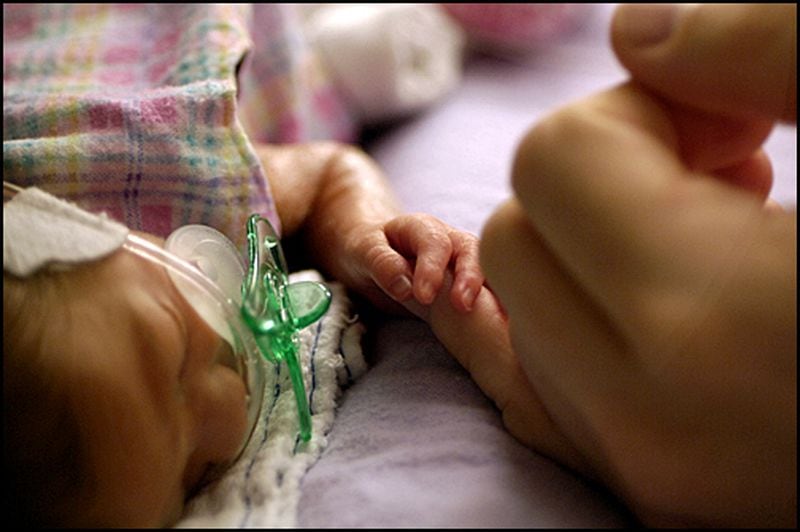Georgia’s infant mortality increase last year was one of the four worst in the nation, with about seven babies dying for every 1,000 births.
In Georgia, 892 infants died in 2022, 116 more infant deaths than the year before. U.S. infant deaths surpassed 20,500 in 2022 — 610 more than the year before nationwide. Black babies had the highest rate of death in the U.S., 10.86 per 1,000 births.
More than 30 states saw at least slight rises in infant mortality rates in 2022. But only four states — Georgia, Iowa, Missouri and Texas — had what is considered significant, statistically clear increases. Georgia’s overall infant mortality increase was 13%, compared to 3% nationwide.
The national rise, from 2021 to 2022, was the largest in two decades, according to the Centers for Disease Control and Prevention. Ky Lindberg, CEO of Healthy Mothers, Healthy Babies Coalition of Georgia, was dismayed but not shocked.
“It seems as if I am a broken record,” Lindberg said. “Yet the contributing factors attributed to this increase in infant mortality also track with factors attributing to our concerning maternal mortality rates,” she said, citing limited resources for women who give birth.
That includes access to doctors, access to perinatal education, and overall “social determinants of health” — challenging living conditions that make it more likely that a person gets sick and faces difficulty in navigating the health care system. For example, if people live in rural areas and don’t have their own car, that’s a big deal when half of Georgia counties have no OB/Gyn. About nine Georgia counties have no doctor at all.
The report did not examine the cause of the increase, but most of the babies born in 2022 were conceived in 2021, when maternal deaths soared by 40 percent as the pandemic worsened a health crisis among pregnant women in the country. Questions remain about how the pandemic may have affected — and continues to affect — pregnancy as well as babies born during the pandemic. Pregnant women are at an increased risk of severe illness from COVID, and they are more likely to experience complications from the coronavirus that can threaten their pregnancy and developing baby.
Garrison Douglas, a spokesman for Gov. Brian Kemp’s office, pointed out that Kemp has worked with the Georgia Legislature to expand Medicaid coverage to lower-income new moms from six months after giving birth to one year.
“Along with 29 additional states who saw some form of an increase, this nationwide increase in the infant mortality rate remains a concern, which is why under Governor Kemp’s leadership Georgia has taken targeted action, from expanding Medicaid coverage for postpartum care and TANF benefits for expectant mothers to launching a home visitation program in at-risk and underserved rural communities during pregnancies and early childhood — the effects of which are not yet covered in the data for this particular report.”
Georgia remains one of 10 states that have rejected government-funded medical coverage for all adults who live below the poverty line. Experts say that would help women in their fertility years to develop a network of doctors and have better health before they get pregnant.
Those gaps in resources disproportionately affect people of color and lower-income people. According to the March of Dimes, in 2020 the death rate for Black babies was more than double that for white babies in both Georgia and the U.S. A CDC spokesperson said demographic breakdowns on a state level were not yet available for the new 2022 data in the report.
Nationwide, the data in the report showed the increase was among the biggest for white and Native American babies, which narrowed the gap between them and Black babies. According to the March of Dimes, in the 2018 to 2020 period, Black babies nationwide died at more than double the rate of white babies and more than triple the rate of Native American and Pacific Islander babies.
The significant U.S. death increases in the new report occurred among white and Native American infants, infant boys and babies born at 37 weeks or earlier.
”It’s definitely concerning, given that it’s going in the opposite direction from what it has been,” said Marie Thoma, a University of Maryland researcher who studies maternal and infant mortality.
Dr. Eric Eichenwald, a Philadelphia-based neonatologist, called the new data “disturbing,” but said experts at this point can only speculate as to why a U.S. statistic that generally has been falling for decades rose sharply in 2022.
Some of the chief causes it cited included bacterial meningitis and pregnancy complications. But one possible issue is that in 2022 hospitals were full and caregivers were more stretched.
In 2022, some people who had been more isolated for pandemic reasons began to congregate more. RSV and flu infections rebounded last fall after two years of pandemic precautions, filling pediatric emergency rooms across the country.
Credit: Courtesy of David Zentz/Flickr
Credit: Courtesy of David Zentz/Flickr
“That could potentially account for some of it,” said Eichenwald, who chairs an American Academy of Pediatrics committee that writes guidelines for medical care of newborns.
Infant mortality is the measure of how many babies die before they reach their first birthday.
The number of babies born too early in Georgia has been steadily rising, a growing number of infants at risk for lifelong physical and intellectual disabilities, according to the March of Dimes.
Pregnancy-related complications are closely tied to infant deaths as well. New moms in Georgia were increasingly likely to die from pregnancy over the last two decades, so much so that their rate of death from pregnancy rose more steeply than almost all other states in the U.S., according to recent data from the Institute for Health Metrics and Evaluation at the University of Washington and Harvard University’s Mass General Brigham.
While the situation is dire, the Georgia chapter of the nonprofit March of Dimes see hope in a new home visit pilot program for pregnant women, their unborn or recently born babies and their siblings. Such in-home help is a key priority for the March of Dimes, which recently scored Georgia with an “F” for its worsening record of maternal and infant mortality.
State public health staff are also convincing some hospitals to implement best practices with women facing problematic births. Nonprofits have worked with doulas — childbirth professionals — to get more on board with pregnant women who wouldn’t normally be able to afford one. All such initiatives have been shown to reduce pregnancy-related sickness and death.
But they are piecemeal. With hospital initiatives, DPH has no ability to force hospitals to join in.
The U.S. infant mortality rate has been worse than other high-income countries, which experts have attributed to poverty, inadequate prenatal care and other factors. But even so, the U.S. rate generally gradually improved because of medical advances and public health efforts. The national rate rose to 5.6 infant deaths per 1,000 live births in 2022, up from 5.44 per 1,000 the year before, the new report said.
The nationwide increase may seem small, but it’s the first statistically significant jump in the rate since the increase between 2001 and 2002, said Danielle Ely, the CDC report’s lead author. She also said researchers could not establish whether the 2022 rise was a one-year statistical blip — or the beginning of a more lasting trend.
Overall in the U.S., the death rate from all causes fell 5% in 2022 — a general decrease that’s been attributed to the waning impact of the COVID-19 pandemic, especially on people 65 and older. U.S. maternal deaths also fell last year.
”It would appear that some of the states could be having a larger impact on the (national) rate,” Ely said, adding that smaller increases elsewhere also have an effect — and that it’s hard to parse out exactly what places, policies or other factors are behind the national statistic.
AJC staff writer Helena Oliviero and the Associated Press contributed to this report.
About the Author








